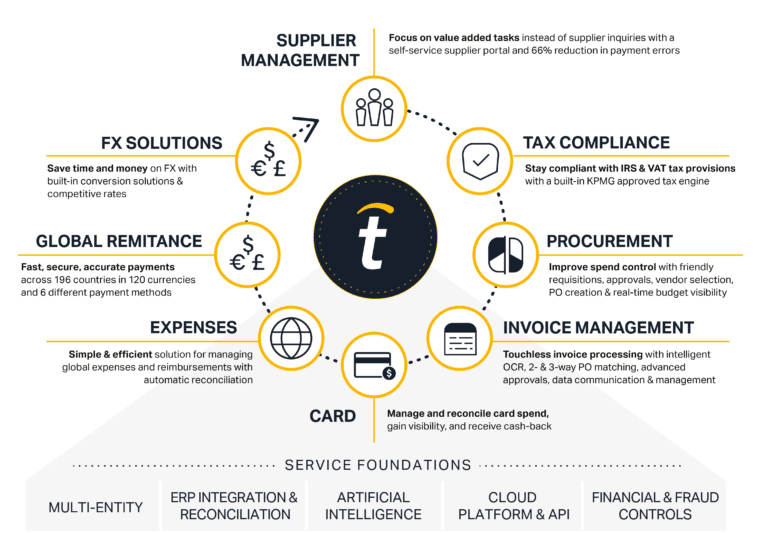The Total Guide to Microsoft Dynamics Business Central ERP
Our guide covers everything you need to know about Microsoft Dynamics Business Central ERP, including integration, market fit, pricing, features, and comparisons. Access our free e-book to learn more about automating accounts payable and global mass payments with Microsoft Business Central.
What is Microsoft Dynamics Business Central ERP?
Microsoft Dynamics Business Central, originally called NAV or Navision, is an ERP system rebranded in 2018. Microsoft Dynamics Business Central is now the on-premises and private cloud-based version of Microsoft Dynamics NAV. The cloud version of Microsoft Dynamics Business Central, deployed on the Microsoft cloud platform Azure, is called Dynamics 365 Business Central. ERP is enterprise resource planning software, including accounting software.
Microsoft Dynamics Business Central includes financial management, consisting of general and cost accounting, cash flow management and forecasting, built-in reporting (including Excel, Power BI business intelligence dashboards), the Copilot AI assistant for Business Central app English language versions, an Outlook add-in, Power Platform’s Power Apps and Power Automate add-ins for Dynamics 365 Business Central), exports in XBRL, dimensions, multi-currency, budgets vs. actual results with variance analysis, intercompany transactions, and consolidation. Employees needing limited viewing of Business Central can gain access with a Microsoft 365 license, which includes Office 365 for Excel, Word, PowerPoint, and Outlook software apps). Operating systems for Business Central include Windows for computers and iOS or Android for mobile devices.

Features
Key Features and Benefits of Microsoft Dynamics Business Central
Microsoft Dynamics Business Central includes these key features and benefits.

Advanced inventory, cost accounting, distribution, and manufacturing
Advanced warehouse configurations and inventory management features include moving items using Movement Worksheets, calculating bin replenishment, and bin content. Business Central prepares a bill of materials (BOM) with product components and tracks raw materials, work-in-process (WIP), and finished goods for manufacturers. The Microsoft Dynamics Business Central ERP solution handles cycle counts and annual physical inventory counts with adjustments for reconciliation.

Drop shipments from vendors to customers, with required POs
For eCommerce sellers, drop shipments from vendors to customers (without warehousing the items) reduces costs and saves time.

Basic accounts receivable and accounts payable
Business Central includes core accounting features for manually recording and reporting accounts receivable and accounts payable and receiving or making payments.

Fixed assets accounting, depreciation, maintenance and insurance tracking
Fixed assets accounting for plant, property, and equipment (PPandE) is robust in Business Central, allowing you to record, depreciate with a choice of methods, value, and assign insurance policies to equipment to maintain adequate insurance levels.

Time sheet tracking and project management
Use time sheets in Business Central to track time for projects, absence, assembly orders, and service orders. Business Central lets you copy project lines to a timesheet.

Manual employee expense reimbursement
Business Central has manual entry, reimbursement, reconciliation, and Journal posting of employee expenses, with currency conversion.

Use of any corporate spending card for employee expenditures not requiring a PO
Although Microsoft Business Central doesn’t issue its own spending cards, it works with other cards for employee purchases.

Procurement purchase orders or purchase invoices
For Procurement, you can manually create purchase orders or purchase invoices that dynamically update inventory levels in Business Central.

Manual payouts
Make payouts without invoices by manually creating a purchase invoice and making batch payments through the Payments Journal.

Choice of integrated CRM systems, eCommerce, and other add-on solutions
Users can choose integrations with Microsoft Dynamics Sales or Salesforce CRM software and a wide variety of storefronts like Shopify and other eCommerce integrations. Microsoft Dynamics Business Central integrates with other add-on business solutions, including software that automates payables and global mass payments.
Modules
Microsoft Dynamics Business Central Modules
Microsoft Dynamics Business Central provides core and optional modules for managing business processes throughout the organization.

Financial management
Business Central Financial Management includes a chart of accounts, bank reconciliation, basic accounts receivable and accounts payable, budgeting, deferrals, multi-currency, multi-dimensional real-time reports, and financial statements.
Sales and marketing (plus integration with Microsoft Dynamics 365 Sales or Salesforce CRM)
Business Central sales functionality includes sales order management, including quotes and blanket orders, with partial shipments, sales invoices and credit memos, return orders, sales line pricing and discounting, campaign pricing, and offers bulk invoicing with Microsoft Bookings. Choose between using Microsoft Dynamics Sales for customer relationship management or integrating with third-party Salesforce CRM.


Purchases and payables
Purchases functionality in Business Central includes manually managing quotes, blanket orders, and creating purchase orders and purchase return orders, including partial return shipments and linking with replacement POs. You also can set up, post, and purchase invoices and purchase credit memos for accounts payable.
Inventory management
Business Central inventory management includes tracking items, SKUs, serial and lot numbers, and multiple locations. It handles item variants, such as colors and revisions, to make inventory setup and tracking easier. With Business Central, you can manage inventory cycle counting.


Supply chain management
Business Central supply chain management provides planning functionality in addition to inventory control. It handles drop shipments, calculates inventory availability, identifies stockouts with the Sales and Inventory Forecast extension, and determines accurate order shipping and delivery dates.
Project management
Microsoft Dynamics Business Central project management tracks resources for labor and equipment and handles project prices and costs. Its capabilities include capacity management and tracking, assigned job ownership, and management for fixed-price jobs and time-and-material jobs. Time tracking for projects uses Time Sheet software integration with Project Management (or Service).


Service management
Service management includes pricing, service level contracts and quotes, warranty management, assigning personnel to work orders, dispatching, tracking service orders parts and labor with history, customer-initiated service requests, and measuring service order profitability.
Warehouse management
Business Central warehouse management by location may use (but doesn’t require) bins, including picklists, warehouse receipts, and warehouse shipments.


Manufacturing
Manufacturing includes assembly and versioned product bills of materials (BOM) with standard costs, capacity planning with routing for production orders, material requirements planning (MRP), machine centers, production orders, subcontracting, finite loading of capacity-constraint resources, and scrap recording for cost management.
Human resources
With Business Central Human Resources, you can set up employees with filtering codes, maintain employment contracts, qualifications, and contacts, and track employee absences. Business Central handles confidential employee information.

Modernize Business Central with Tipalti AP automation
Business Central is a key financial tool for mid-sized businesses, but AP often demands tailored solutions. Explore how executives are improving AP and global payables efficiency within Business Central.
Industries
Industries Using Microsoft Dynamics Business Central
Small businesses, mid-sized companies, and organizations in many industries use Microsoft Dynamics Business Central. The cost of this business management solution makes Microsoft Dynamics Business Central ideal for medium-sized businesses.
Industries include software, IT services and tech, manufacturing, distribution and supply chain, eCommerce and retail, service companies, repair shops, oilfield services companies, financial services, healthcare, and educational institutions. Besides businesses, non-profit organizations and government entities use Microsoft Dynamics Business Central.
Microsoft Dynamics Business Central has a large user base in manufacturing and distribution companies because its inventory management, manufacturing, production order, sales order, distribution, and cost accounting features are very advanced to meet their business needs.
CPAs in accounting firms use Microsoft Dynamics Business Central to access and review clients’ Business Central software accounts through the Accountant Role Center.
Companies needing project accounting and project management functionality for their business operations use Microsoft Dynamics Business Central.
E-commerce and retail companies use the MS Dynamics Business Central system with their choice of third-party add-on business application integrations, including storefronts for their business operations.

Software

IT Services and Tech

Distribution and Supply Chain

E-commerce and Retail

Service Companies

Repair Shops

Oilfield Service Companies

Financial Services

Healthcare

Educational Institutions

Nonprofits

Government Entities
Implementation
How to Implement and Use Microsoft Dynamics Business Central
Microsoft Dynamics Business Central is sold through resellers who are independent software vendors (ISVs) and Dynamics Business Central Partners. These ISV partners are consultants who offer implementation, training, and other consulting services. Using an experienced partner leverages their successful implementation experience. Getting Ready for Doing Business is Microsoft’s Business Central resource page.

Step 1
Team
Assign an implementation team leader and functional area team members. Have the CEO announce the Microsoft Dynamics Business Central planned implementation to all employees to gain project acceptance.

Step 2
Select an ISV Consultant
An experienced Business Central independent software vendor (ISV) consultant will contribute expertise and guidance, an implementation plan, and training. Budget funds and sign a contract that includes the scope of work.

Step 3
Planning
Determine implementation goals, assign tasks, and set milestones and deadlines. Determine which third-party software integrations to add to Business Central.

Step 4
Training
Train system users. Some highly trained team members may provide hands-on training to functional area users. Access online Business Central training and documentation.

Step 5
Data Migration and Testing
Clean data, map, and migrate data from your current accounting software or ERP system. Test the system in the Business Central sandbox environment before going live.
Step 6
Post-implementation review
Have team members document Business Central implementation project strengths and weaknesses to improve future software implementations and create a report.
How Does AP Automation Software Integration Work With Microsoft Dynamics Business Central?
Integrated AP automation software modernizes Microsoft Dynamics Business Central and streamlines business process workflows, increasing efficiency and reducing fraud. Tipalti SaaS AP automation and global mass payments software products automate the entire accounts payable and payments process, starting with self-service supplier onboarding. Tipalti flat-file integration with Microsoft Dynamics Business Central works well for large batch payments up to a volume of thousands.
During the self-service supplier onboarding process through the Supplier Hub, your company collects W-9 or W-8 forms from suppliers before the first payment. Suppliers choose their preferred payment method for payments to 200+ countries in 120 currencies and provide the required payment details. Later, suppliers will view a list of invoices, payment status, and history in the Supplier Hub.
Tipalti cloud AP automation software automates and digitizes invoice processing from supplier validation to error checking with 26,000+ payment rules, 3-way or 2-way matching, guided approvals with communications and automated routing, electronic global payments in large batches with automated global regulatory compliance, simple tax compliance reports with tracked calendar-year supplier payments, and real-time payment reconciliation. Tipalti replaces manual data entry and paper-based systems through digital transformation.
Tipalti AP automation uses Tipalti AI℠ for extracting fields digitally from supplier invoices, automatic general ledger account coding, exceptions flagging, approvals routing, and Ask Tipali AI℠, the digital assistant for making spend queries to aid data-driven decisions.
Scalable Tipalti end-to-end accounts payable automation software saves your team 80% time, reduces additional hiring needs, accelerates the accounting close by up to 25%, reduces errors by 66%, and helps to control fraud risk.

Tipalti Mass Payments software quickly and efficiently processes a large volume of payouts to affiliates, influencers, creatives, streamers, publishers, freelancers, and independent contractors. Besides integrating with Microsoft Dynamics Business Central (or other ERP or accounting software), Tipalti Mass Payments software integrates with some performance marketing system platforms, using automated payout calculations to make global payments.
Tipalti’s unified finance automation software platform can be augmented with other products, including its advanced FX solutions, Multi-FX and FX Hedging for payables, Procurement software for purchase requisition intake and approval with automatic PO creation, and Expenses for employee expense management and reimbursement. Tipalti also offers a corporate spending card with spending rewards called the Tipalti Card to approved users.
The Tipalti Expenses, Multi-FX, and FX Hedging products combine with Tipalti’s AP automation software. Multi-FX uses a centralized virtual payment account for all subsidiaries and entities and avoids the need to set up a regional international banking network. FX Hedging locks in foreign exchange rates for paying supplier invoices in accounts payable.
Tipalti Expenses includes a mobile app that captures expense receipts through photos and automatically extracts data fields for expense claim processing. Expense report approvers for team members can also use the mobile app to accept expenses in compliance with your company’s travel and expense policy and reject any non-qualifying expenses before the reimbursement is paid.
How Much Does Microsoft Dynamics Business Central Cost?
Microsoft Dynamics NAV total cost includes the software license, consulting costs for implementation, customization, and training, plus add-ons. Request competitive quotes for Business Central and services from independent software vendor (ISV) Dynamics 365 partners in the Microsoft network. Standard SaaS subscription pricing for Microsoft Dynamics 365 Business Central is:
| Dynamics 365 Business Central Essentials | $70/per user per month |
| Dynamics 365 Business Central Premium | $100/per user per month |
| Dynamics 365 Business Central Team Members | $8/per user per month |
Recommendations
